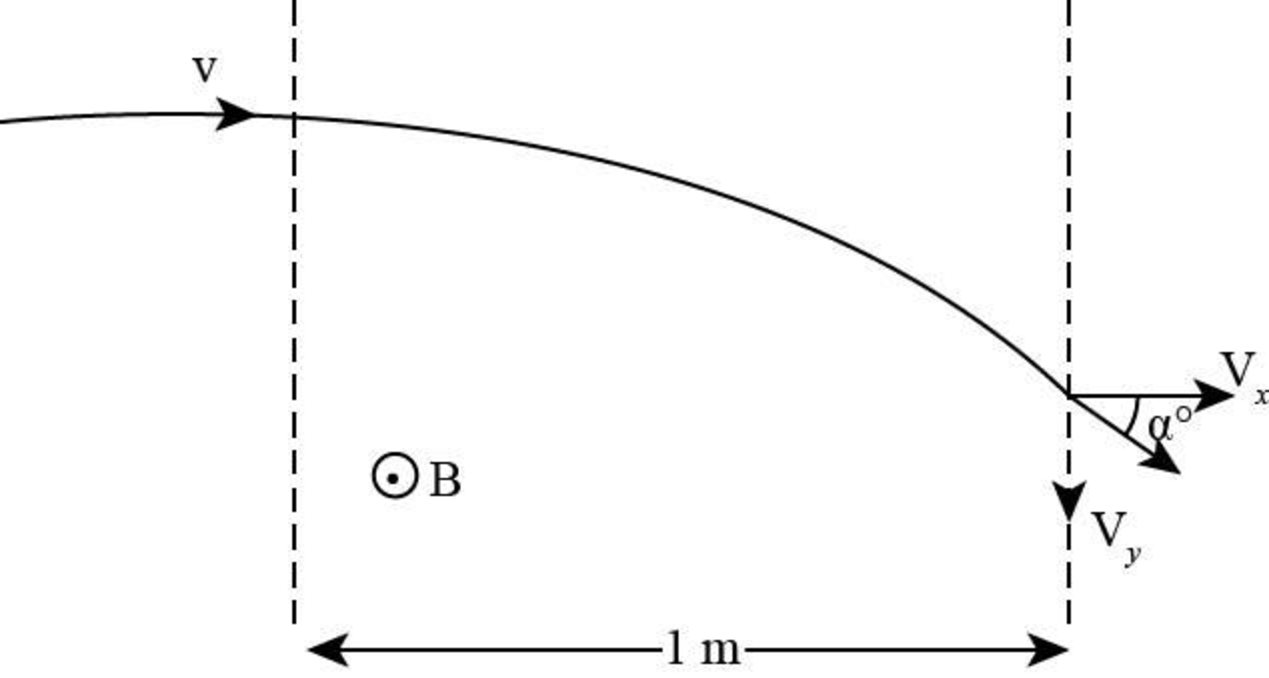
Concept explainers
(a)
The angle between the initial velocity vector of the proton beam and the velocity vector after the beam emerges from the field.
(a)
Answer to Problem 78CP
The angle between the initial velocity vector of the proton beam and the velocity vector after the beam emerges from the field is
Explanation of Solution
Consider the free body diagram of the particle as shown below.

Figure-(1)
Write the expression to calculate the initial velocity of the proton.
Here,
Write the expression to calculate the final velocity of the proton.
Here,
Write the expression to calculate the angle between the velocity.
Conclusion:
Substitute
Substitute
Substitute
Therefore, the angle between the initial velocity vector of the proton beam and the velocity vector after the beam emerges from the field is
(b)
The y component of the protons momentum as they leave the magnetic field.
(b)
Answer to Problem 78CP
The y component of the protons momentum as they leave the magnetic field is
Explanation of Solution
Write the expression to calculate the velocity in x direction.
Here,
Write the expression to calculate time required by the proton to travel.
Here,
Write the expression to calculate the acceleration of the proton.
Here,
Write the expression to calculate the velocity in the y direction.
Here,
Write the expression to calculate the momentum.
Here,
Conclusion:
Substitute
Substitute
Substitute
Substitute
Substitute
Therefore, the y component of the protons momentum as they leave the magnetic field is
Want to see more full solutions like this?
Chapter 29 Solutions
Bundle: Physics for Scientists and Engineers with Modern Physics, Loose-leaf Version, 9th + WebAssign Printed Access Card, Multi-Term
- (a) For a spherical capacitor with inner radius a and outer radius b, we have the following for the capacitance. ab C = k₂(b- a) 0.0695 m 0.145 m (8.99 × 10º N · m²/c²)( [0.145 m- 0.0695 m × 10-11 F = PF IIarrow_forwardA pendulum bob A (0.5 kg) is given an initialspeed of vA = 4 m/s when the chord ishorizontal. It then hits a stationary block B (1kg) which then slides to a maximum distanced before it stops. Determine the value of d.The coefficient of static friction between theblock and the plane is μk = 0.2. The coefficientof restitution between A and B is e = 0.8.Ans: d=1.0034 marrow_forwardFigure 29-43 Problem 12. ••13 In Fig. 29-44, point P₁ is at distance R = 13.1 cm on the perpendicular bisector of a straight wire of length L = 18.0 cm carrying current i = 58.2 mA. (Note that the wire is not long.) What is the magnitude of the magnetic field at P₁ due to i? P2° R R Larrow_forward
- Checkpoint 1 The figure shows the current i in a single-loop circuit with a battery B and a resistance R (and wires of neg- ligible resistance). (a) Should the emf arrow at B be drawn pointing leftward or rightward? At points a, B C R b, and c, rank (b) the magnitude of the current, (c) the electric potential, and (d) the electric potential energy of the charge carriers, greatest first.arrow_forwardPls help ASAParrow_forwardPls help asaparrow_forward
 Principles of Physics: A Calculus-Based TextPhysicsISBN:9781133104261Author:Raymond A. Serway, John W. JewettPublisher:Cengage Learning
Principles of Physics: A Calculus-Based TextPhysicsISBN:9781133104261Author:Raymond A. Serway, John W. JewettPublisher:Cengage Learning Physics for Scientists and Engineers, Technology ...PhysicsISBN:9781305116399Author:Raymond A. Serway, John W. JewettPublisher:Cengage Learning
Physics for Scientists and Engineers, Technology ...PhysicsISBN:9781305116399Author:Raymond A. Serway, John W. JewettPublisher:Cengage Learning
 Physics for Scientists and Engineers with Modern ...PhysicsISBN:9781337553292Author:Raymond A. Serway, John W. JewettPublisher:Cengage Learning
Physics for Scientists and Engineers with Modern ...PhysicsISBN:9781337553292Author:Raymond A. Serway, John W. JewettPublisher:Cengage Learning Physics for Scientists and Engineers: Foundations...PhysicsISBN:9781133939146Author:Katz, Debora M.Publisher:Cengage Learning
Physics for Scientists and Engineers: Foundations...PhysicsISBN:9781133939146Author:Katz, Debora M.Publisher:Cengage Learning College PhysicsPhysicsISBN:9781305952300Author:Raymond A. Serway, Chris VuillePublisher:Cengage Learning
College PhysicsPhysicsISBN:9781305952300Author:Raymond A. Serway, Chris VuillePublisher:Cengage Learning





